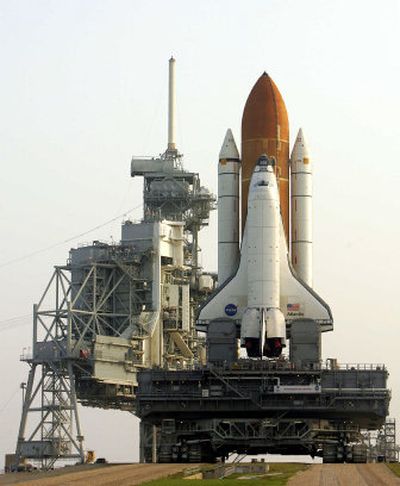Atlantis rolled out for late-August launch

CAPE CANAVERAL, Fla. – NASA rolled space shuttle Atlantis out to the launch pad Wednesday for an end-of-the-month flight to resume construction on the International Space Station, which has been on hold for more than three years.
The four-mile trek from the Vehicle Assembly Building started shortly after 1 a.m. and took less than eight hours. It was delayed twice this week because of stormy weather.
In the next few days, fuel and power lines will be hooked up to the vehicle, the shuttle’s auxiliary power units will be tested and cargo will be loaded onto the shuttle.
Next week, the Atlantis crew arrives at the Kennedy Space Center for several days of dress rehearsals that include a practice launch countdown, an exercise to practice escaping from the launch pad and instruction on using emergency equipment.
Atlantis has not flown since October 2002, and there has been no construction on the International Space Station since December 2002. The deadly Columbia accident in early 2003 halted all expansion of the orbiting space lab and forced a reduction in the crew size from three to two.
The crew size returned to three members last month after space shuttle Discovery delivered European astronaut Thomas Reiter to the space station.
During the 11-day mission, Atlantis’ six astronauts are scheduled to conduct three spacewalks and install a 35,000-pound addition with giant solar arrays to power the station.
Atlantis’ launch will be the second of the year and only the third shuttle mission since the Columbia disaster killed seven astronauts. Two missions to the space station aboard space shuttle Discovery, in July 2005 and last month, were considered test flights to determine whether NASA had fixed a problem with shedding foam on the external tank that doomed the Columbia crew.
Falling foam from Columbia’s external tank punched a hole in a wing, allowing fiery gases to penetrate the shuttle during re-entry.
The window for launching Atlantis starts Aug. 27 and lasts until Sept. 13, but NASA managers on Thursday will consider opening the window a day earlier. The biggest factor in their decision is whether lighting during the launch will be good enough to capture clear images of the shuttle’s tank, particularly in areas called ice-frost ramps where foam has fallen off in the past.